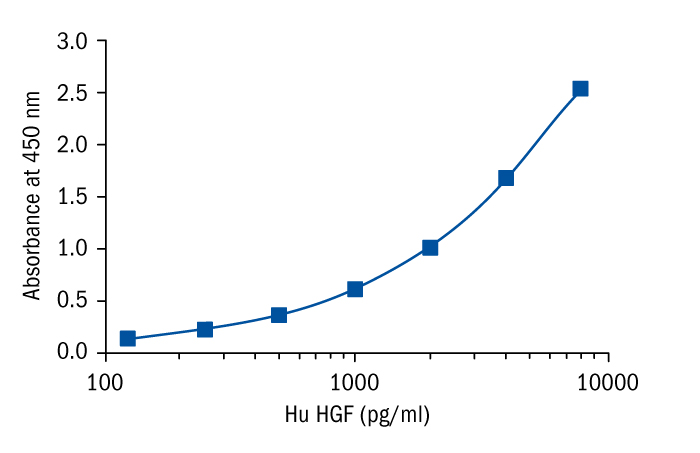Type
Sandwich ELISA, Biotin-labelled antibody
Applications
Serum, Saliva
Shipping
At ambient temperature. Upon receipt, store the product at the temperature recommended below.
Storage/Expiration
Store the complete kit at 2–8°C. Under these conditions, the kit is stable until the expiration date (see label on the box).
Calibration Curve
Calibration Range
125–8000 pg/ml
Limit of Detection
20 pg/ml
Intra-assay (Within-Run)
n = 8; CV = 5,9%
Inter-assay (Run-to-Run)
n = 8; CV = 5.8%
Spiking Recovery
97,80%
Dilution Linearity
95,40%
Features
- It is intended for research use only
- The assay time is less than 3.5 hours
- The kit measures HGF in serum and saliva
- Assay format is 96 wells
- Standard is recombinant protein based
- Components of the kit are provided ready to use, concentrated or lyophilized
Research topic
Cytokines and chemokines and related molecules
Summary
Hepatocyte growth factor (HGF) is a multifunctional cytokine that is related to many diseases. HGF is a dimeric molecule, with molecular weight of 84 kDa, composed of an subunit 69 kDa and a subunit (34 kDa), linked by a disulfide bond.
HGF, also called Scatter factor, is produced by stromal cells, and stimulates epithelial cell proliferation, motility, morphogenesis and angiogenesis in various organs via tyrosine phosphorylation of its receptor, c Met. In fetal stages, HGF-neutralization, or c-Met gene destruction, leads to hypoplasia of many organs, indicating that HGF signals are essential for organ development.
Endogenous HGF is required for self-repair of injured livers, kidneys, lungs and others. In addition, HGF exerts protective effects on organs (including the heart and brain) via anti-apoptotic and anti-inflammatory signals. During organ diseases, blood HGF levels increases significantly.
In animal injury models of the liver, lung, or kidney, the level of HGF activity significantly increased in the damaged organs, with a peak within 1 day after the injury.
In summary, endogenous HGF is important for inducing self-repair responses in numerous organs. The paracrine or endocrine pathway that is predominantly involved in tissue repair depends on the degree, or kind, of injury. Regardless of the pathway, HGF is secreted as a pro-HGF and then converted to the active form only at the injury sites by HGF-activators. This local activation system may explain the injury-specific c-Met activation that elicits a regenerative response only in an injured organ.
HGF is also involved in cancer invasion and metastasis. The discovery of NK4 as an HGF antagonist has promoted research in cancer biology, pathology and therapy.
Hepatocyte growth factor and its tyrosine kinase receptor (Met) play important roles in myocardial function, both, in physiological and pathological situations. In the developing heart, HGF influences cardiomyocyte proliferation and differentiation. In the adult, HGF/Met signaling controls heart homeostasis and prevents oxidative stress in normal cardiomyocytes.In the injured heart, HGF plays important roles in cardioprotection by promoting: prosurvival (anti-apoptotic and anti-autophagic) effects in cardiomyocytes, angiogenesis, inhibition of fibrosis, anti-inflammatory and immunomodulatory signals, and regeneration through activation of cardiac stem cells. Furthermore, the putative role of elevated HGF as prognostic marker of severity in patients with cardiac diseases is discussed. HGF and HGF based molecules has been examined as new therapeutic tools for the treatment of cardiac diseases.
Find documents for the lot
Example Instructions for Use (RUO)
Example Instructions for Use (RUO)

